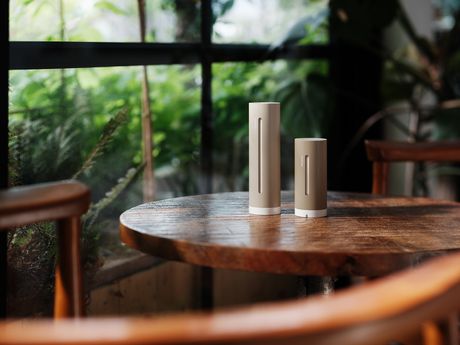
Netatmo onthult het nieuwe Weerstation ORIGINAL

Tot 50% korting op geselecteerde productenKopen

U bent waarschijnlijk bekend met het principe van een radiator die wordt verwarmd met warm water. Hij is vaak wit en biedt de meest behaaglijke warmte op koude winteravonden. Aangesloten op het centrale verwarmingssysteem, verwarmt de radiator van staal, gietijzer of aluminium, een zeer groot aantal woningen waaronder misschien ook wel de uwe.
Het werkingsprincipe van een radiator die op het centrale verwarmingssysteem is aangesloten, is zeer eenvoudig. Het warme water dat in de radiator circuleert dat ervoor zorgt dat de warmte zich door de kamer verspreidt. Dit water wordt eerst verwarmd door het centrale verwarmingssysteem: de gasketel, oliegestookte ketel, houtgestookte ketel, zonnewarmte of een warmtepomp.
Zodra dit water is opgewarmd wordt het in de stalen, gietijzeren of aluminium radiator gestuwd, die de warmte over de hele kamer verspreidt. Het is goed om te weten dat de warmte op twee manieren kan worden opgewekt, afhankelijk van het type radiator: ofwel straling van een hete muur, ofwel convectie door de beweging van het water.
Tussen de hoge of lage temperatuur radiator, de stalen, gietijzeren of gegoten aluminium radiator, de verticale of horizontale radiator… u heeft keuze te over! Ongeacht het model kan een radiator in elke kamer van uw huis of appartement worden geïnstalleerd. De warmte die hij produceert is aangenaam en het vermogen varieert naargelang het model.
Op de meeste radiatoren kunt u gemakkelijk een Netatmo Slimme Thermostaat installeren om uw verwarming op afstand te programmeren en te bedienen. Verhoog het rendement, bespaar energie en geniet van lagere verwarmingsrekeningen!
Een radiator kan gemaakt zijn van één van de 3 belangrijkste thermische materialen: gietijzer, staal of gegoten aluminium. Ook kunnen we een onderscheid maken tussen lage temperatuur-radiatoren en hoge temperatuur-radiatoren. Op het centrale verwarmingssysteem aangesloten warm water radiatoren onderscheiden zich eveneens door hun vermogen, rendement en prijs, die sterk kunnen variëren.
De gietijzeren warmwater radiator is één van de oudste van de radiatoren. Dit type radiator is vaak aangesloten op centrale-verwarmingsinstallaties van enkele tientallen jaren oud. Hij is herkenbaar aan zijn gelijke componenten, die op elkaar worden gestapeld tot het vereiste vermogen is verkregen om de gewenste warmte te produceren. Hij is vaak wit en erg effectief in gebruik, ook duurt het even voordat hij de gewenste temperatuur bereikt.
Deze vaak grote radiatoren bieden langdurige warmte, dat wil zeggen dat ze nog lang warmte blijven leveren nadat ze zijn uitgeschakeld. Het is een belangrijk thermisch element om energie te besparen en een woning efficiënter te verwarmen. De gelijkmatige en constante warmte die door een gietijzeren radiator wordt geleverd, is zeer waardevol en biedt een groot thermisch comfort, zelfs in de minst geïsoleerde en koudste kamers. De meeste gietijzeren radiatoren werken volgens het principe van stralingsverwarming.
Stalen radiatoren vervangen geleidelijk aan de gietijzeren voorganger, en zorgen voor een zeer snelle verwarming. Deze stalen warm water radiatoren bestaan uit staalplaten die in paren aan elkaar zijn bevestigd. Dit zijn dus 1, 2 of zelfs 3 holle panelen die samen de radiator vormen, en die worden gevuld met het warme water dat door het centrale verwarmingssysteem wordt geproduceerd. Stalen radiatoren produceren de langdurigste warmte en warmen vrij snel op.
Bij de meest efficiënte stalen radiatoren zijn de panelen voorzien van vinnen, die de warmteverspreiding door middel van convectie bevorderen. Het rendement van dit type radiator stijgt gemakkelijk van 50% tot 70%.
Het laatste materiaal dat voor sommige warm water radiatoren wordt gebruikt is aluminium, of preciezer gezegd gegoten aluminium. Aluminium radiatoren moeten echter enkel worden gebruikt voor de best geïsoleerde kamers, omdat de verwarming niet langdurig is, de radiator warmt snel op maar koelt ook weer razendsnel af. Bij gebruik van aluminium radiatoren is het belangrijk dat alle radiatoren in huis ook van aluminium zijn, om elektrolyse-effecten te voorkomen. Ten slotte dient te worden opgemerkt dat aluminium radiatoren gevoelig zijn voor corrosie.
Afgezien van het materiaal is ook de keuzen tussen een lage temperatuur- of een hoge temperatuur-radiator belangrijk.
De klassieke radiator werkt met water op hoge temperatuur (70-90°C), maar er bestaat ook een ander, zuiniger type: de lage-temperatuurradiator. De eerste kent vaak een stijlvoller ontwerp en wordt verkocht tegen een lagere prijs dan de tweede. De lage temperatuur-radiator is over het algemeen groter, zuiniger en comfortabeler, maar kan veel duurder zijn dan de hoge temperatuur-radiator.
De lage temperatuur radiator vermindert warmte- en energieverlies in het gehele centrale verwarmingscircuit. Kortom, hij verwarmt tot ongeveer 50 graden maximaal, biedt een kleiner temperatuurverschil voor een rendement dat 10 tot 15% hoger ligt dan dat van een hogetemperatuurradiator en een groter thermisch comfort. Maar dat is nog niet alles, want hij zorgt ook voor minder stofverplaatsing. Ten slotte heeft de warm water radiator met lage temperatuur een vermogensreserve in geval van uitzonderlijk lage buitentemperaturen.
Zoals u ziet, kan een warm water radiator gemaakt zijn van gietijzer, staal of gegoten aluminium, met een modern design of klassiek ontwerp, en bestaat in een lage temperatuur of hoge temperatuur uitvoering. Maar dat is nog niet alles: een radiator, ongeacht het type, kan verticaal, horizontaal, extra dun, op maat gemaakt zijn!
Het hangt allemaal af van waar u uw radiator wilt installeren. Er zijn verschillende opties, dus u kunt net zo goed de ruimte en de warmteverdeling optimaliseren door de indeling van de radiator af te stemmen op uw kamer.
Een radiator van aluminium heeft een prijs tussen 100 en 300 euro, wat vergelijkbaar is met de prijs van een stalen radiator, hoewel sommige modellen van de laatste al voor enkele tientallen euro's te vinden zijn. Uiteindelijk loopt de prijs van een gietijzeren radiator al snel op, van enkele honderden euro's tot 3.000 euro.
De keuze van een radiator hangt dus af van vele criteria: materiaal (gietijzer, staal of aluminium), lage of hoge temperatuur, plaatsing (verticaal, horizontaal, enz.). Maar ook de prijs is een belangrijke factor bij de keuze!